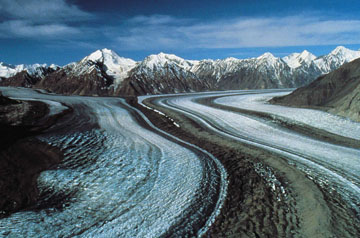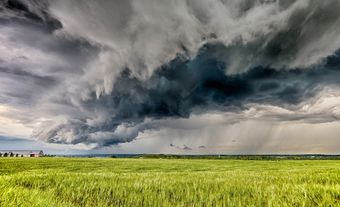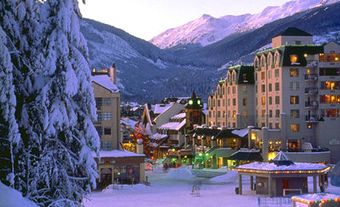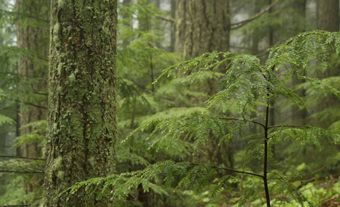Canada’s national parks are protected areas established under federal legislation to preserve Canada’s natural heritage. They are administered by Parks Canada, a government agency that evolved from the world’s first national parks service, the Dominion Parks Branch, established in 1911. The National Parks System Plan, developed in 1970, divided Canada into 39 natural regions and set the goal of representing each region with at least one national park. Canada now has 48 national parks and national park reserves in 30 of these regions. In total, the parks cover more than 340,000 km2, which is over 3 per cent of Canada’s landmass. They protect important land and marine habitats, geographical features and sites of cultural significance. National parks also benefit local economies and the tourism industry in Canada.
(This is the full-length entry about National Parks of Canada. For a plain-language summary, please see National Parks of Canada (Plain-Language Summary).)
Protection and Preservation
The goal of Canada’s national parks system, in addition to representing and protecting examples of the country’s geographic heritage, is to preserve its natural heritage for future generations by encouraging public understanding, appreciation and enjoyment of nature. Visitor and educational opportunities include hands-on experiences in the national parks, educational programs in schools and homes, and research programs.
For millennia, Canada’s landscape was primarily shaped by natural forces. Now, agricultural and industrial activities are altering the environment at an accelerated pace. The creation and management of national parks help stem these human-caused changes, protecting natural environments. Aside from the opportunity to protect and maintain landscapes and wildlife, each park provides a chance to restore degraded ecosystems and allow them to persist in a healthy state.
Preserving the natural state of park environments and encouraging safe public use of parks requires a delicate balance. Maintaining this balance is a major task for staff. They must study and document park resources, and then apply this knowledge to minimize human impact on park ecosystems, while offering visitors experiences that leave them inspired and informed. Parks Canada also works with Indigenous knowledge holders to plan, manage and operate national parks.
Beginnings

The Canadian national parks system began in November 1885, when the federal government under Sir John A. Macdonald set aside an area of approximately 26 km2 on the northern slope of Alberta’s Sulphur Mountain for public use. This area, the Cave and Basin Hot Springs, was the beginning of what is now Banff National Park.
First Nations had used the hot springs before the arrival of colonists in the area. The first settlers to come across the springs were three Canadian Pacific Railway (CPR) employees working on the construction of the first transcontinental railway through the Rocky Mountains in 1883. Rather than grant private title to the lands to individuals or companies, the federal government decided that the hot springs should be preserved for the benefit of all Canadians. A similar decision in the United States established the Arkansas Hot Springs as the US’s first federal reserve in 1832.
Economic interests also played a role. Developing the springs as a tourist destination would increase traffic on the CPR and help ensure the railway’s viability.
In 1886, the government hired a Dominion land surveyor to undertake a legal survey of the Hot Springs Reserve. This work resulted in a report by the commissioner of Dominion Lands stating that “a large tract of country lying outside of the original reservation presented features of the greatest beauty, and was admirably adapted for a national park” (see also Dominion Lands Act).
The following year, the government introduced a bill in the House of Commons to establish the first national park in Canada. The Rocky Mountains Park Act, creating what is now Banff National Park, was passed on 23 June 1887. Renowned for its mountains and hot springs, Banff is recognized as one of the core protected areas in the Yellowstone to Yukon corridor, where many organizations collaborate to ensure that grizzly bears and wolves can continue to migrate through large-scale ecosystems.
Exclusion of Indigenous Peoples
Beginning with the creation of Banff, government authorities banned Indigenous peoples from national parks. They were also prohibited from hunting and gathering on these lands, which they had traditionally used and occupied. In 1887, Banff superintendent George Stewart wrote of the local Stoney people: “Their destruction of the game and depredations among the ornamental trees make their too frequent visits to the Park a matter of great concern.” In 1936, members of the Keeseekoowenin Ojibwe band were expelled from Riding Mountain National Park several years after its establishment. As the Ojibwe left, park wardens set fire to their homes. These policies were not unique to national parks: in the late 19th century, First Nations were also forced from Stanley Park in Vancouver and Algonquin Provincial Park in Ontario.

Some Indigenous commentators have disputed the popular image of national parks as “pristine” or “untouched” wilderness, arguing that this narrative obscures a long human history. According to Nathan Cardinal, manager of resource conservation at Gulf Islands National Park Reserve: “All these landscapes were actively managed by First Nations for millennia.”
While agreements with Indigenous peoples are now key to the management of most national parks, the federal government did not begin to change its exclusionary parks policies until the 1970s.
Growth and Organization

Banff demonstrated the commercial potential of public parks. The CPR’s Banff Springs Hotel, completed in 1888, quickly became a popular destination for wealthy tourists. Interest in the development of other reserves ran high among members of Parliament and Canadian Pacific Railway officials. Between 1886 and 1895, three new mountain reserves were set aside, unavailable for “sale, settlement or squatting.” These later became Yoho, Glacier and Waterton Lakes national parks. The availability of large tracts of undeveloped public lands in Western Canada, coupled with the government’s interest in bringing tourists west on the new transcontinental railway, facilitated establishment of these mountain national parks.
Early in the 20th century, the government began developing national parks in Eastern Canada, starting with St. Lawrence Islands National Park (now Thousand Islands National Park) in 1904.
The world’s first national parks administration, the Dominion Parks Branch, was formed in Canada in 1911 under the authority of the Department of the Interior. James B. Harkin, the first parks commissioner, served from 1911 to 1936. During his tenure, nine national parks were established: Elk Island (1913), Mount Revelstoke (1914), Point Pelee (1918), Kootenay (1920), Wood Buffalo (1922), Prince Albert (1927), Riding Mountain (1929), Georgian Bay Islands (1929) and Cape Breton Highlands (1936). Harkin emphasized protection of the natural resources of the new parks and their tourism value to the nation’s economy.
Did you know?
Harkin also believed that these natural landscapes offered a moral benefit to city dwellers — an escape from degenerate urban environments.
Harkin oversaw the development of the National Parks Act, which was approved by Parliament in 1930. Section four of the Act sets the guiding philosophy for the management of national parks. They are areas “dedicated to the people of Canada, for their benefit, education and enjoyment… and the parks shall be maintained and made use of so as to leave them unimpaired for the enjoyment of future generations.” While this statement continues as the foundational principle guiding the management of national parks, the Act has been amended several times, and is now titled the Canada National Parks Act.
By 1970, 20 national parks were either established or in the planning stages, the relevant agreements having been signed with provincial governments.
The national parks system was joined over the years by other Parks Canada programs. National parks are one component of Parks Canada’s system of heritage sites, which includes national historic parks, national historic sites, heritage canals, Canadian heritage rivers and national marine conservation areas, as well as one Canadian landmark (a group of eight pingos near Tuktoyaktuk, Northwest Territories).
In 1998, Parliament passed the Parks Canada Agency Act, which made Parks Canada — formerly a branch within government departments — a separate agency with a new governance structure. Its core mission, however, remained the same.
National Parks System Plan

Before the 1970s, the national parks network was not developed in any systematic way. Rather, it was a collection of special places, created in some cases by political opportunism, accidents of geography or the efforts of dedicated citizens. National parks were also created for a variety of purposes, including protecting outstanding scenic areas, providing regional recreation areas, creating wildlife preserves or stimulating flagging economies in areas of chronic underemployment. There was no vision or long-term goal.
In 1968, Jean Chrétien, then the federal minister in charge of parks, called for the creation of 40 to 60 new national parks by 1985, the centennial year of Banff National Park. The National Parks System Plan was developed in 1970 to determine the locations of these new parks. It divided Canada into 39 natural regions, with the goal of representing each natural region in the national parks system.
By the centennial year of Banff National Park in 1985, there were 31 national parks and national park reserves. Although this fell well short of Chrétien’s 1968 goal, he had overseen the establishment of 10 new parks during his mandate.
Current Network
There are now 48 national parks and national park reserves in Canada. Thirty regions are currently represented by national parks and national park reserves, and some regions contain more than one park. Nine regions are not yet represented.
National park reserves are established in areas affected by unresolved land claims and accepted by the Government of Canada for negotiation. These areas are designated to become national parks, but the final boundaries and other terms will only be finalized upon the resolution of the land claims.
Since 1985, the following new national parks or national park reserves have been created: Vuntut (YT); Aulavik, Nááts’ihch’oh, Tuktut Nogait and Thaidene Nëné (NT); Qausuittuq, Quttinirpaaq, Sirmilik and Ukkusiksalik (NU); Akami-Uapishkᵁ-KakKasuak-Mealy Mountains and Torngat Mountains (NL); Sable Island (NS); Bruce Peninsula and Rouge (ON); Wapusk (MB); Gwaii Haanas and Gulf Islands (BC). Auyuittuq, first established as a national park reserve in Nunavut in 1976, became a national park in 2001.
Parks Canada is also working to establish national parks in several unrepresented natural regions. Feasibility studies have been done for a national park reserve in the South Okanagan-Similkameen area of south-central British Columbia. The 2017 budget tabled by Prime Minister Justin Trudeau’s Liberals stated that the government was working to establish a national park in the Manitoba Lowlands, on the northwest shore of Lake Winnipeg.
Government collaboration with Indigenous communities is key to establishing new national parks. For example, in 2009, Parks Canada partnered with the Dehcho First Nations, who sought to protect the South Nahanni River watershed. The collaboration resulted in a six-fold expansion of Nahanni National Park Reserve in the Northwest Territories. Nahanni became the third-largest national park in Canada. This was also one of the most significant conservation decisions in a generation, protecting habitat for grizzly bears and caribou. The realization of the Manitoba Lowlands park will depend upon the support of local First Nations, which have not always backed the plan.

National parks and reserves range from Quttinirpaaq, approximately 800 km from the North Pole, to Point Pelee at the southernmost tip of Canada’s mainland; from Terra Nova on the east shore of Newfoundland to Gwaii Haanas on Haida Gwaii (formerly known as the Queen Charlotte Islands) in British Columbia. The total area of Canada’s national parks is more than 340,000 km2. This is over six times the size of Nova Scotia, and equal to over 3 per cent of Canada’s landmass. The national parks range in size from Wood Buffalo, the equivalent of Switzerland, to Point Pelee, which, for its small size of 15 km2, is biologically rich.
Challenges and Opportunities
To establish new parks in the 10 unrepresented regions of the national parks system, Parks Canada must secure the support of provincial and territorial governments, Indigenous communities and localities. This process can take years and can involve complex negotiations across multiple jurisdictions.
Habitat fragmentation is among the most prevalent threats to the ecological integrity of national parks, particularly those in southern Canada. It occurs when lands surrounding a park have been transformed into agricultural, urban, mining or forest-harvesting lands. Because many of the habitats within southern parks are fragments of the original, they are directly affected by changes in adjacent lands. Certain species currently existing in the parks may not survive in the long term unless conservation measures are taken in co-operation with local and regional land managers.
Parks Canada continues to work to establish regional approaches through partnerships with the forestry and agriculture industries, Indigenous communities, private landowners, environmental groups, provincial parks agencies and others. Some examples of this broad regional approach to park management include the biosphere reserve programs, as well as the model forest programs implemented by the now-dissolved Canadian Model Forest Network in Pacific Rim, Jasper, Prince Albert, Fundy and Gros Morne national parks.

Ensuring that national parks remain relevant to Canadian society by conserving and presenting some of Canada’s iconic landscapes is a priority for Parks Canada. It works to protect important examples of the nation’s biodiversity and help mitigate the impact of climate change on ecosystems. The agency also works to ensure that youth, newcomers and the increasing number of Canadians living in cities have unique and inspiring opportunities within national parks. In keeping with this mandate, Rouge National Urban Park was established in the Rouge Valley area near Toronto in 2015. It is Canada’s first national urban park.
Legislation and Policy
With the exception of certain areas of Nahanni National Park Reserve, national parks are protected under the Canada National Parks Act from all forms of industrial development including mining, forestry, oil and natural gas exploration and development and hydro-electric development, as well as commercially extractive activities such as sport hunting. Sportfishing is permitted in designated areas of most parks.
The first national parks policy, produced in 1964, drew attention to the importance of protecting natural resources in the parks. In 1986, a separate policy for national marine parks, now called national marine conservation areas, was approved.
The Parks Canada Guiding Principles and Operational Policies, in place since 1994, include policies for both parks and marine conservation areas. They emphasize that, to protect resources, natural ecological processes must be allowed to function with minimal interference from people. They also provide a framework for the long-term planning of new parks and the provision of quality visitor services and appropriate recreational opportunities.

The Guiding Principles specify, among other guidelines, that a park boundary should: 1) be of a size and configuration that protects ecosystems and landscape features representative of a natural region; 2) accommodate the habitat requirements of viable populations of wildlife species; 3) include an undisturbed core; 4) maintain drainage basin integrity; and 5) offer opportunities for public understanding and enjoyment.
In 1988 and 2000, Parliament amended the legislation administering the national parks to focus on ecological integrity. The Canada National Parks Act currently states: “Maintenance or restoration of ecological integrity, through the protection of natural resources and natural processes, shall be the first priority of the Minister when considering all aspects of the management of parks.” The Act’s intent is to ensure that natural ecological processes continue to function with minimal interference. This will in turn ensure the continued natural evolution of land and water environments and preserve the species that live in them.
Management Strategies
Active manipulation of natural ecological processes does take place under certain conditions in national parks. This is necessary if the balance of park ecosystems has been so altered by human activities that a natural environment cannot be restored through natural ecological processes. It is also employed if park visitors, facilities or neighbouring lands are threatened. Culls of overabundant species when they impact endangered ones (e.g., deer overgrazing in Point Pelee), the reintroduction of endangered species (e.g., the black-footed ferret) and the use of controlled burns to restore fire-dependent ecosystems are all examples of active manipulation to maintain or restore ecological integrity.
Many national parks, particularly in the North, are located in areas in which Indigenous peoples continue to rely on local natural resources. Cultures in these areas often maintain a close relationship to the land. Traditional subsistence harvesting by Indigenous communities continues in many national parks, subject to conservation of the resource and co-operative management approaches through management boards with strong representation by Indigenous peoples.
The effective protection and management of national parks requires an intimate understanding of park resources, the ecological processes controlling and influencing them, and the human impact on natural processes. Parks Canada has developed several tools to help achieve this understanding, including comprehensive natural resources databases, regularly updated for all parks. Using such systems, scientists monitor indicators of the health of park ecosystems and identify the potential impacts and stresses on parks.
A park’s land and water areas are classified into five zones according to their fragility and their capacity to accommodate visitors. In Zone I, access is strictly limited or prohibited. Zone II comprises most of the national park lands and focuses on protection and limited recreational use. Motorized access is prohibited in Zones I and II. Zones III and IV provide more visitor facilities and allow more activities. Zone V comprises town sites, visitor centres and park administration offices. Parks Canada can also designate Culturally and Environmentally Sensitive Areas that “require special recognition or management not provided through zoning designation.”
Many of the species currently at risk in Canada are found on lands administered by Parks Canada. Under the federal Species at Risk Act (SARA), Parks Canada plays a significant role in the protection and recovery of endangered species. The agency does this by: 1) leading and participating in recovery teams; 2) developing and supporting recovery strategies and priority actions; 3) educating Canadians on species at risk; 4) collecting detailed information on species’ distribution and population status; and 5) assessing how activities might affect species at risk within Parks Canada’s protected heritage areas and monitoring these activities for their effects. (See also Endangered Plants; Endangered Animals.)
Visitor Activities
The early national parks focused on providing recreational facilities for leisure activities such as golf, tennis and downhill skiing. Today, the aim is to provide outdoor recreational opportunities consistent with the long-term protection of natural resources, requiring a minimum of facilities.
Hiking, cycling, canoeing, cross-country skiing and snowshoeing are examples of activities considered compatible with a park setting. Naturalists are on hand in some parks to interpret the environment to visitors and provide information on recreational activities.

International Role
Canada’s national parks system is part of a global network of more than 200,000 protected areas in 244 countries and territories. According to the International Union for the Conservation of Nature and Natural Resources (IUCN), this network covers about 15 per cent of the planet’s inland and territorial water areas and 10 per cent of its coastal and marine areas.
As a member of the IUCN, Parks Canada contributes to the development of internationally accepted standards and criteria for parks worldwide. It is also the primary agency responsible for fulfilling Canada’s obligations under the World Heritage Convention of the United Nations Education, Scientific and Cultural Organization (UNESCO). The convention recognizes the responsibility of all nations to protect places of such unique natural and cultural value that they are considered part of the heritage of all humankind.

Kluane, Nahanni, Wood Buffalo, Gros Morne and Waterton Lakes national parks and reserves, L’Anse Aux Meadows National Historic Site, the Burgess Shale of Yoho National Park, and Anthony Island (better known by its Haida name, SGang Gwaay) in Gwaii Haanas National Park Reserve have been designated World Heritage Sites. The combined boundaries of Yoho, Jasper, Banff, and Kootenay national parks, along with Mount Robson, Mount Assiniboine, and Hamber provincial parks in BC make up the Canadian Rocky Mountain Parks World Heritage Site.
A number of Canada’s national parks are part of the world’s network of biosphere reserves under UNESCO’s Man and Biosphere Programme. This initiative recognizes outstanding examples of natural ecosystems throughout the world. The national parks that are core protected areas within biosphere reserves include Waterton Lakes, Riding Mountain, Bruce Peninsula, Thousand Islands, Fundy, Kejimkujik and Georgian Bay Islands. In addition to helping protect specific natural areas, these parks contribute to broader regional and global conservation initiatives.
Canada’s National Parks and National Park Reserves
|
National Park or Reserve |
Province or Territory |
Year Established |
Park Area (km2) |
|
Alberta |
1885 |
6,641 |
|
|
British Columbia |
1886 |
1,349.3 |
|
|
British Columbia |
1886 |
1,313.1 |
|
|
Alberta |
1895 |
505 |
|
|
Alberta |
1907 |
10,878 |
|
|
Alberta |
1913 |
194 |
|
|
British Columbia |
1914 |
259.7 |
|
|
Thousand Islands National Park (formerly St Lawrence Islands National Park) |
Ontario |
1914 |
24 |
|
Ontario |
1918 |
15 |
|
|
British Columbia |
1920 |
1,406.4 |
|
|
Alberta and Northwest Territories |
1922 |
44,741 |
|
|
Saskatchewan |
1927 |
3,874.3 |
|
|
Manitoba |
1929 |
2,973.1 |
|
|
Ontario |
1929 |
13.5 |
|
|
Nova Scotia |
1936 |
948 |
|
|
Prince Edward Island |
1937 |
21.5 |
|
|
New Brunswick |
1948 |
205.9 |
|
|
Newfoundland and Labrador |
1957 |
399.9 |
|
|
Québec |
1970 |
536.1 |
|
|
Newfoundland and Labrador |
1973 |
1,805 |
|
|
Nova Scotia |
1974 |
403.7 |
|
|
Québec |
1974 |
240.4 |
|
|
Yukon |
1976 |
21,980 |
|
|
Northwest Territories |
1976 |
30,000 (approx.) |
|
|
Ontario |
1978 |
1,877.8 |
|
|
New Brunswick |
1979 |
239.2 |
|
|
Nunavut |
National Park Reserve 1976; National Park 2001 |
19,089 |
|
|
Saskatchewan |
1981 |
906.4 |
|
|
Québec |
1984 |
110 |
|
|
Yukon |
1984 |
9,750 |
|
|
Nunavut |
1988 |
37,775 |
|
|
Ontario |
1987 |
156 |
|
|
Northwest Territories |
1992 |
12,200 |
|
|
British Columbia |
1993 |
1,495 |
|
|
Yukon |
1995 |
4,345 |
|
|
Manitoba |
1996 |
11,475 |
|
|
Northwest Territories |
1998 |
18,890 |
|
|
Nunavut |
1999 |
22,252 |
|
|
British Columbia |
2001 |
285.8 (land only) |
|
|
Nunavut |
2003 |
20,500 |
|
|
Newfoundland and Labrador |
NPR 2005; NP 2008 |
9,700 |
|
|
British Columbia |
2010 |
36 (land only) |
|
|
Sable Island National Park Reserve of Canada |
Nova Scotia |
2011 |
34 |
|
Nááts’ihch’oh National Park Reserve |
Northwest Territories |
2012 |
4,850 |
|
Nunavut |
2015 |
11,000 |
|
|
Akami-Uapishkᵁ-KakKasuak-Mealy Mountains National Park Reserve |
Newfoundland and Labrador |
2015 |
10,700 |
|
Ontario |
2015 |
79.1 |
|
|
Thaidene Nëné National Park Reserve |
Northwest Territories |
2019 |
14,000 |

 Share on Facebook
Share on Facebook Share on X
Share on X Share by Email
Share by Email Share on Google Classroom
Share on Google Classroom






